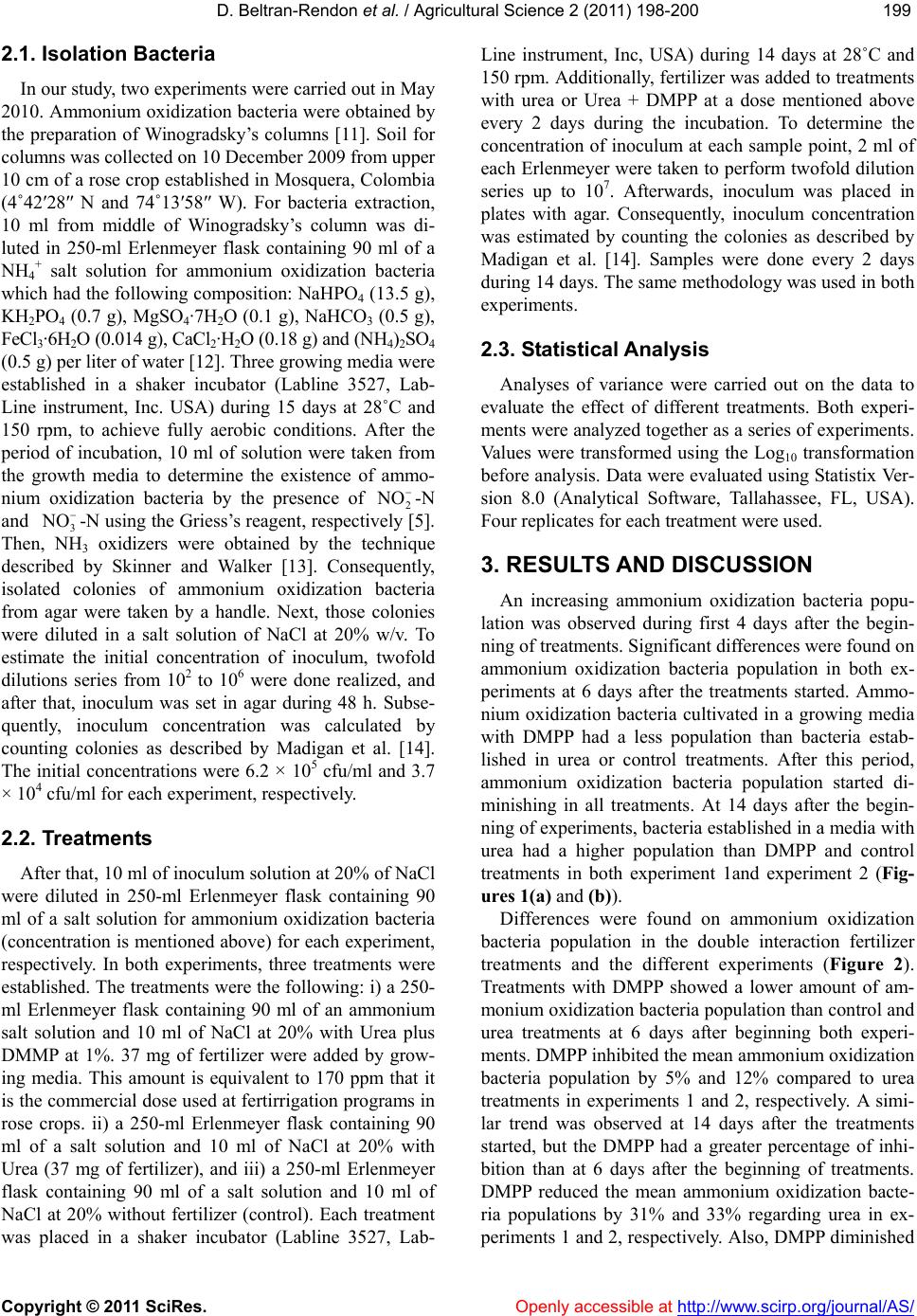
D. Beltran-Rendon et al. / Agricultural Science 2 (2011) 198-200
Copyright © 2011 SciRes. Openly accessible at http://www.scirp.org/journal/AS/
199199
ts were carried out in May
acteria were obtained by
th
2.1. Isolation Bacteria
In our study, two experimen
2010. Ammonium oxidization b
e preparation of Winogradsky’s columns [11]. Soil for
columns was collected on 10 December 2009 from upper
10 cm of a rose crop established in Mosquera, Colombia
(4˚42′28″ N and 74˚13′58″ W). For bacteria extraction,
10 ml from middle of Winogradsky’s column was di-
luted in 250-ml Erlenmeyer flask containing 90 ml of a
NH4
+ salt solution for ammonium oxidization bacteria
which had the following composition: NaHPO4 (13.5 g),
KH2PO4 (0.7 g), MgSO4·7H2O (0.1 g), NaHCO3 (0.5 g),
FeCl3·6H2O (0.014 g), CaCl2·H2O (0.18 g) and (NH4)2SO4
(0.5 g) per liter of water [12]. Three growing media were
established in a shaker incubator (Labline 3527, Lab-
Line instrument, Inc. USA) during 15 days at 28˚C and
150 rpm, to achieve fully aerobic conditions. After the
period of incubation, 10 ml of solution were taken from
the growth media to determine the existence of ammo-
nium oxidization bacteria by the presence of 2
O
-N
and 3
O-N using the Griess’s reagent, respectively [5].
Then, NH3 oxidizers were obtained by the teue
descr by Skinner and Walker [13]. Consequently,
isolated colonies of ammonium oxidization bacteria
from agar were taken by a handle. Next, those colonies
were diluted in a salt solution of NaCl at 20% w/v. To
estimate the initial concentration of inoculum, twofold
dilutions series from 102 to 106 were done realized, and
after that, inoculum was set in agar during 48 h. Subse-
quently, inoculum concentration was calculated by
counting colonies as described by Madigan et al. [14].
The initial concentrations were 6.2 × 10 5 cfu/ml and 3.7
× 104 cfu/ml for each experiment, respectively.
2.2. Treatments
chniq
ibed
f inoculum solution at 20% of NaCl
ml Erlenmeyer flask containing 90
m
cal Analysis
arried out on the data to
treatments. Both experi-
m
teria popu-
r the begin-
ni
n the double interaction fertilizer
tr
After that, 10 ml o
were diluted in 250-
l of a salt solution for ammonium oxidization bacteria
(concentration is mentioned above) for each experiment,
respectively. In both experiments, three treatments were
established. The treatments were the following: i) a 250-
ml Erlenmeyer flask containing 90 ml of an ammonium
salt solution and 10 ml of NaCl at 20% with Urea plus
DMMP at 1%. 37 mg of fertilizer were added by grow-
ing media. This amount is equivalent to 170 ppm that it
is the commercial dose used at fertirrigation programs in
rose crops. ii) a 250-ml Erlenmeyer flask containing 90
ml of a salt solution and 10 ml of NaCl at 20% with
Urea (37 mg of fertilizer), and iii) a 250-ml Erlenmeyer
flask containing 90 ml of a salt solution and 10 ml of
NaCl at 20% without fertilizer (control). Each treatment
was placed in a shaker incubator (Labline 3527, Lab-
Line instrument, Inc, USA) during 14 days at 28˚C and
150 rpm. Additionally, fertilizer was added to treatments
with urea or Urea + DMPP at a dose mentioned above
every 2 days during the incubation. To determine the
concentration of inoculum at each sample point, 2 ml of
each Erlenmeyer were taken to perform twofold dilution
series up to 107. Afterwards, inoculum was placed in
plates with agar. Consequently, inoculum concentration
was estimated by counting the colonies as described by
Madigan et al. [14]. Samples were done every 2 days
during 14 days. The same methodology was used in both
experiments.
2.3. Statisti
Analyses of variance were c
evaluate the effect of different
ents were analyzed together as a series of experiments.
Values were transformed using the Log10 transformation
before analysis. Data were evaluated using Statistix Ver-
sion 8.0 (Analytical Software, Tallahassee, FL, USA).
Four replicates for each treatment were used.
3. RESULTS AND DIS CUSSION
An increasing ammonium oxidization bac
lation was observed during first 4 days afte
ng of treatments. Significant differences were found on
ammonium oxidization bacteria population in both ex-
periments at 6 days after the treatments started. Ammo-
nium oxidization bacteria cultivated in a growing media
with DMPP had a less population than bacteria estab-
lished in urea or control treatments. After this period,
ammonium oxidization bacteria population started di-
minishing in all treatments. At 14 days after the begin-
ning of experiments, bacteria established in a media with
urea had a higher population than DMPP and control
treatments in both experiment 1and experiment 2 (Fig-
ures 1( a) and (b)).
Differences were found on ammonium oxidization
bacteria population i
eatments and the different experiments (Figure 2).
Treatments with DMPP showed a lower amount of am-
monium oxidization bacteria population than control and
urea treatments at 6 days after beginning both experi-
ments. DMPP inhibited the mean ammonium oxidization
bacteria population by 5% and 12% compared to urea
treatments in experiments 1 and 2, respectively. A simi-
lar trend was observed at 14 days after the treatments
started, but the DMPP had a greater percentage of inhi-
bition than at 6 days after the beginning of treatments.
DMPP reduced the mean ammonium oxidization bacte-
ria populations by 31% and 33% regarding urea in ex-
periments 1 and 2, respectively. Also, DMPP diminished